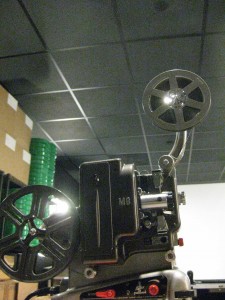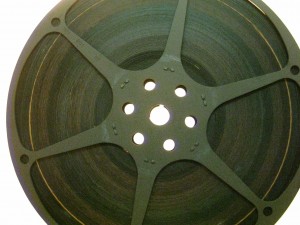digging for treasures
October 26th, 2011
Today we had a colleague from another part of Harvard come by with some donors and their 1930s & 1940s 8mm films.
While we generally utilize the Steenbeck or the KEM editing tables for viewing 16mm or 35mm prints, when it comes to the small gauge formats, the choices are different. Shrunken, brittle 8mm and super 8 films that won’t stand the stress of projector gears are viewed on tabletop viewers that are very gentle on the perforations. The image, however, is never as bright as we would like, and the image area is small. When the film is in good shape, we like to be able to project it, especially on occasion when there is more than one person who needs to see it.
I inspected & cleaned the films, repaired some splices, added leader & determined the films were project-able. We gathered in the Conservation Center’s little theatre, where I laced up our 8mm projector (I call it the Cadillac of 8mm projectors), the Bolex-Palliard M8.
There were 6 films to view, and the first was the most exciting for most of the audience. B&W, from the late 1930s, the film was a record of an archaeological dig. Highlights for the HFA staff included a shot of a prairie dog running out of a ditch with several babies attached to its teats! It looked like a mammal with too many legs.
The screening was successful. We were able to provide a great service – access to a format not easy to work with. We also provided conservation services. The donors were able to watch the films, see people long dead and places long changed. The Harvard staff were afforded an opportunity to view the material with the donors and hear their reactions to the pictures moving on the screen.
Altogether a pleasant way to spend an afternoon.
